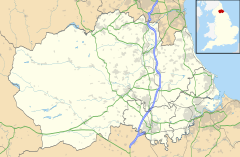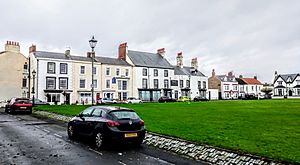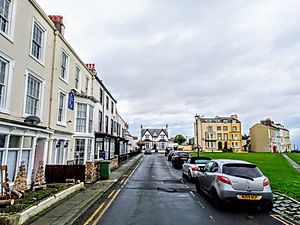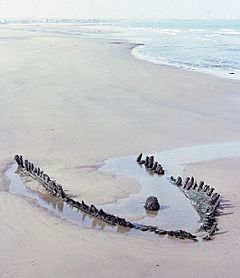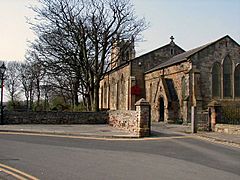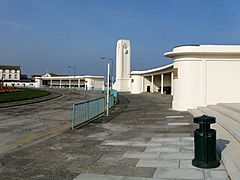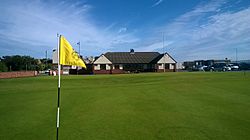Seaton Carew facts for kids
Quick facts for kids Seaton Carew |
|
|---|---|
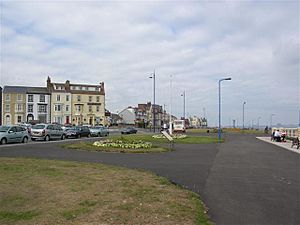 The sea front |
|
| Population | 6,018 (2001) |
| OS grid reference | NZ52323006 |
| Unitary authority |
|
| Ceremonial county | |
| Region | |
| Country | England |
| Sovereign state | United Kingdom |
| Post town | HARTLEPOOL |
| Postcode district | TS25 |
| Dialling code | 01429 |
| Police | Cleveland |
| Fire | Cleveland |
| Ambulance | North East |
| EU Parliament | North East England |
| UK Parliament |
|
Seaton Carew is a fun seaside resort in County Durham, North East England. About 6,018 people lived here in 2017. It sits right on the North Sea coast, next to Hartlepool and where the River Tees meets the sea. The name 'Seaton' means a farm or village by the sea. The 'Carew' part comes from a Norman French family called Carou. They owned land and settled in the area a long time ago.
Contents
Exploring Seaton Carew's Past
Seaton Carew has a long and interesting history. People lived here even in Roman times. Sometimes, old Roman coins and items are found on the beach.
Later, around the time of King Henry I, the area became known as Seaton Carrowe. In medieval times, people made salt here by drying out sea water. The leftover ash was dumped and still forms grassy mounds on the golf course today.
A long time ago, a special religious house called a Gilbertine priory might have been in the Seaton area. However, no one has found it yet. In 1667, a fort was built at Seaton Snook. This was to protect the mouth of the River Tees, especially from the Dutch. You can still see parts of these old forts today.
Seaton Carew started as a small fishing village. But in the 1700s and 1800s, it grew into a popular holiday spot. Wealthy Quaker families from Darlington came here for their vacations. Many stayed in the fancy houses and hotels built along the seafront. They also enjoyed The Green, a grassy square facing the sea.
In 1867, after a big storm, many old Spanish silver dollar coins were found hidden in the sand.
Golfing History
In 1874, the Durham and Yorkshire Golf Club started here. It's now called Seaton Carew Golf Club. It began with a 14-hole course near the coast. More holes were added later. In 1925, a famous golf course designer, Alister MacKenzie, helped improve the course.
In 1882, Seaton Carew became part of West Hartlepool. The Museum of Hartlepool tells a story about a small disagreement that happened here a long time ago.
North of Seaton, there used to be a large steel and iron factory. This factory later became part of the British Steel Corporation. It is thought to have closed in 1979.
Seaton Carew Lighthouse
To help ships find their way, two lighthouses were built in Seaton Carew in 1838. One, the Low Light, was on the seafront. The other, the High Light, was further inland. These lighthouses helped guide ships into the River Tees. They were stopped from being used in 1892. The High Light building was likely taken down in 1902.
The 1900s in Seaton Carew
An electric tramway opened in 1902. This connected Hartlepool to Seaton Carew. Trams ran along the seafront until 1927. After that, trams no longer ran in the Hartlepools area.
In 1907, a cargo ship called the SS Clavering got stuck near the mouth of the River Tees during a storm. The Seaton Carew and Hartlepool lifeboats worked together for 31 hours. They saved 39 people from the ship! The RNLI gave special Silver Medals to the lifeboat coxswains for their bravery.
A factory that made zinc was built here between 1907 and 1908. It used to bring in zinc materials from Australia. The factory made zinc, lead, and silver, along with sulphuric acid.
World War One
During World War I, from 1916 to 1919, there was an RAF airstrip south of Seaton Carew. Seaplanes were also kept in Seaton Channel. This base helped protect the North East of England from air attacks.
In 1916, a German airship called the L 34 attacked Hartlepool. A pilot from Seaton Carew, Lieutenant Ian Vernon Pyott, chased the airship. He fired at it, and the L 34 caught fire and fell into the sea. All the crew were lost. People saw the flames from far away.
In 1921, a war memorial was put up on The Green. It looks like a Victoria Cross on a tall stand.
Between the Wars
In 1930, a Danish ship called the Doris got caught in a storm. It was pushed onto rocks near Hartlepool. Nine crew members were saved by the Hartlepool Lifeboat. The Doris was badly damaged. Its remains are now stuck in the sand at North Gare.
In the 1930s, shelters were built for visitors to the seaside. These had toilets and a life guard station. They were taken down later because they were falling apart. During World War II, defenses like barbed wire and mines were put on the beach to stop any invasion.
After World War Two
In 1949, a big fire broke out in a timber yard in Seaton Carew. It was full of wood used for coal mines. A similar fire had happened in 1922.
In 1969, the Seaton Carew Conservation Area was created. This helps protect the special character of the area.
Recently, the seafront has been improved. Old buildings like the baths and shelters were taken down. The sea defenses were made stronger with large rocks to protect against waves. The walking path along the sea was also made longer, reaching up to Hartlepool Marina.
The 2000s
Seaton Carew was in the news in 2007 because of a strange event. A man named John Darwin was thought to have died in a canoeing accident off Seaton Beach in 2002. But then he walked into a police station in London, saying he was a missing person. This led to a big investigation. After this, someone put up a funny road sign near the railway station that said "Welcome to Seaton Canoe Twinned with Panama." It has since been removed.
What Seaton Carew Offers
Fun for Visitors
Seaton Carew is a great place for tourists! It has four miles of sandy beach, a nice walking path, arcades, and delicious fish and chip restaurants. The beach is kept clean and lifeguards watch over it during summer holidays. In 2019, the main beach got an 'excellent' rating for swimming from the Environment Agency. It also won a Seaside Award from the charity Keep Britain Tidy.
Local Industries
At the end of Zinc Works Road, there is a quarry. It used to be owned by Tarmac. This quarry takes sand and gravel from the beach at North Gare Sands.
Also on Zinc Works Road is a company called Frutarom. They make special chemicals that give strong smells and tastes for food and other products.
To the south, near Seaton Channel, is the Hartlepool Nuclear Power Station. Further along Seaton Channel, at Graythorp, Able UK has a facility that takes apart old ships. On Tees Road, Huntsman Tioxide makes titanium dioxide pigments, which are used in paints and plastics. These chemical companies are part of a big group of industries in the North East of England.
Seaton Carew is also near the mouth of the River Tees. This river is home to Teesport, which is one of the biggest seaports in the United Kingdom.
Culture and Media Connections
Every November, close to Bonfire Night, Seaton Carew has a big fireworks show and carnival. Thousands of people from all over the area come to enjoy it.
Seaton Carew is mentioned in books by science fiction writer Mark Adlard. The bus station also appears in some scenes of the Mike Leigh film Career Girls. A made-up space ship called HMS Seaton Carew was in an episode of the BBC 2 TV show Hyperdrive.
In an episode of the TV show Top Gear, there was a funny joke about the Stig. They said, "Some say that he once lost a canoe on a beach in the north east..." This was a playful reference to the John Darwin incident in Seaton Carew.
Famous Places and Sights
In the north of Seaton, a walking path lets you stroll from Seaton Carew to Hartlepool Marina. From here, you can see amazing views across the North Sea. On a clear day, you can even see all the way to Whitby.
Along the coast, there's a special area called the Hartlepool Submerged Forest. It's a Site of Special Scientific Interest (SSSI), meaning it's protected because of its unique natural features.
To the south, near the slipway, is the old lifeboat station. It's now used as a home. In the southern part of Seaton Carew, along 'The Front', you'll find shops, restaurants, cafes, chip shops, and arcades. These are all things you'd expect to see in a fun seaside town.
The Holy Trinity Church is in the middle of the village. It was built in 1831 and was the village's first proper school. The church was fixed up in 1891.
Many buildings in Seaton Carew are 'listed'. This means they are important and protected because of their history or special design. These include the Church of the Holy Trinity, the bus station, the Marine Hotel, and the Seaton Hotel. Also, some houses and hotels around The Green are listed.
In southern Seaton Carew, you'll find the bus station. It has a cool art deco clock tower and shelters that are also listed buildings. South of this is a car park by the beach. From here, you can see the Seaton Carew Wreck. These are the protected remains of an old wooden ship called a collier that lies on the beach when the tide is out. Many other shipwrecks are found on the beach and just offshore.
Further southeast, beyond the village, is the Seaton Carew Golf Course. This course is between the coastal sand dunes and the Seaton Common marsh. This whole area is called Seaton Dunes and Common and is another SSSI.
The coastal dunes lead southeast to the North Gare breakwater. This is a concrete pier built between 1882 and 1892. It protects the northern side of the mouth of the Tees. You can still see World War II anti-tank blocks on the beach near the breakwater. The breakwater itself is fenced off because parts of it are unsafe.
South of the breakwater is Seaton Snook, a piece of land sticking out into the mouth of the Tees. To the west of Seaton Carew is the Durham Coast Railway Line and the Seaton Carew railway station.
Getting Around Seaton Carew
Seaton Carew is easy to reach by road using the A178 road. It also has its own train station, Seaton Carew railway station.
Stagecoach Hartlepool runs bus services from Monday to Saturday during the day. These buses connect Seaton Carew to Throston Grange and Hartlepool Town Centre. Some buses even go further, to Middlesbrough and Port Clarence. There are no bus services after 6:30 PM.
The railway station has hourly train services run by Northern. You can catch trains to Middlesbrough, Sunderland, Newcastle, and Hexham.
Sports and Activities
Seaton Carew has some great places for sports:
- Seaton United Football Club (SUFC) started in 2015. It helps kids and young people in Seaton Carew and Hartlepool stay fit. They have football teams for children from 4 years old up to the end of primary school. Many teams play in the Russel Foster league on Saturdays. SUFC also helps other teams that need financial support. This makes sure more children can keep playing football.
- Seaton Carew Golf Club Golf has been played here since 1874. This makes it the tenth-oldest golf club in England! This course is known as one of the toughest links golf courses in the British Isles. It often hosts big amateur championships like the Brabazon Trophy.
- Seaton Carew Cricket Club was set up in 1829. They moved to Hornby Park in 1973. This is now the Seaton Sports and Social Club. It supports other sports like Archery, Rugby, and the Seaton Carew Football Club (created in 1998). The club is also a meeting place for many local groups. It's a charity, and all money made goes back into running and improving the club and its fields. This helps support sports and local activities in the community.
- The Sports Domes is another place for various sports activities.
Images for kids


